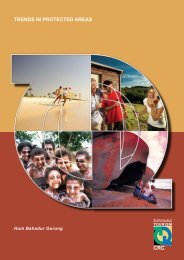icolls - Sustainable Tourism CRC
icolls - Sustainable Tourism CRC
icolls - Sustainable Tourism CRC
You also want an ePaper? Increase the reach of your titles
YUMPU automatically turns print PDFs into web optimized ePapers that Google loves.
ECOLOGY, THREATS AND MANAGEMENT OPTIONS FOR SMALL ESTUARIES AND ICOLLS<br />
Ultimately, the recreational extraction of fish, molluscs and crustaceans has the potential to alter the structure<br />
and function of ICOLL food webs. The ramifications of these changes are likely, in turn, to influence the<br />
management of the system, as symptoms of the changes emerge. For example, if fish extraction leads to<br />
increased frequency, duration and severity of algal blooms, it is likely that local government agencies will ensure<br />
that the frequency and duration of artificially openings of ICOLLs is increased. This in turn may set in train a<br />
cascade of food web and other adjustments with significant consequences for ecological health.<br />
Threatening Process 3: Artificial Berm Breaching and Modification of Flow Regimes<br />
ICOLLs along the south-eastern coast of Australia have been drastically influenced by engineered modifications<br />
and development over the past couple of decades (Pollard 1994a; Zann 2000). In addition to the proliferation of<br />
housing, agricultural and industrial developments, local government agencies have also purposefully influenced<br />
the structure and functioning of ICOLLs through mechanical alteration of opening and closing regimes (Pollard<br />
1994a; Roy et al. 2001; Young & Potter 2002). ICOLLs are often mechanically opened (using bulldozers) for<br />
flood-abatement and flushing purposes (Roy et al. 2001), especially when excessive urban, industrial and/or STP<br />
inputs have stimulated undesirable macrophyte and algal growth (Twomey & John 2001). Whilst this<br />
management strategy reduces the formation and duration of algal blooms (Grange & Allanson 1995; Twomey &<br />
John 2001), the hydrologic changes associated with these practices (including unnaturally high frequencies of<br />
connectance with the ocean) may affect the ecology of ICOLLs (Neira & Potter 1992; Griffiths 2001; Young &<br />
Potter 2002).<br />
Whilst the effects of opening and closing regimes have been investigated to some degree with regard to<br />
changes in fish species composition and abundance (Bell, Cowley & Whitfield 2001; Cowley, Whitfield & Bell<br />
2001; Griffiths 2001; Young & Potter 2002), the overall effect on ICOLL structure and function has not been<br />
examined empirically. However, it is likely that ecological communities can be greatly influenced by variation in<br />
the duration and timing of connectance with the ocean (Cappo et al. 1998; Bilton, Paula & Bishop 2002;<br />
Loneragan & Bunn 1999). When open to the ocean, ICOLLs can be invaded by marine fish species and their<br />
larvae (Neira & Potter 1992). Furthermore, the potential for invasion by exotic species is heightened when<br />
systems are disturbed by hydrodynamic and habitat alterations (Bunn & Arthington 2002). In addition, marked<br />
changes in salinity during and following marine connectance have been shown to promote spawning in some<br />
resident fish species (Griffiths 2001; Young & Potter 2002), thereby influencing within-system population<br />
structure and periodicity of reproductive outputs. Similar consequences are likely for other taxonomic groups;<br />
although very little data exist detailing the response of mollusc, crustacean or polychaete worm species to<br />
opening and closing dynamics (Roy et al. 2001).<br />
In addition to the likely biological consequences of ICOLL connectance to the ocean, the habitat<br />
characteristics of marine and freshwater components of these systems may also be significantly influenced<br />
(Bunn & Arthington 2002; Lercari, Defeo & Celentano 2002). In the case of endangered habitat-specialist fauna<br />
like the Oxleyan Pygmy Perch (Nannoperca oxleyana) and the Honey Blue-eye (Pseudomugil mellis), such<br />
changes have the potential to affect local survival, population size and meta-population processes (Arthington &<br />
Marshall 1999; Hughes et al. 1999; Pusey, Kennard & Arthington 2004).<br />
Artificial opening of ICOLLs can also influence the population dynamics and community composition of<br />
species within these systems, often catastrophically following forced opening events (Pollard 1994b). On<br />
numerous occasions, artificial opening of ICOLLs in New South Wales has led to fish kills brought about by low<br />
dissolved oxygen concentrations from decomposing algae in subsequently re-flooded areas of these systems<br />
(Pollard 1994b). Whilst these dramatic responses to aseasonal and abrupt water level changes have attracted a lot<br />
of negative local attention, resource managers still base their decisions on artificial opening practices on social<br />
issues (flood mitigation and aesthetics) rather than biological data. As a result, the diversity of structural and<br />
ecological conditions that typifies ICOLLs can no longer be found along the New South Wales coast (Roy et al.<br />
2001). Natural evolutionary processes within these systems have been disturbed courtesy of increased opening<br />
frequencies, to the point that there has been a substantial decline in the number of permanently closed ICOLLs in<br />
New South Wales and Victoria (Roy et al. 2001).<br />
The diversity of alterations to the opening and closing regimes of ICOLLs in coastal Australia is<br />
overwhelming. Management plans are largely developed separately for every ICOLL within each coastal region<br />
(depending on the protocols of each local government), ensuring a largely haphazard approach to floodmitigation<br />
and algal bloom response in the coastal zone (Roy et al. 2001).<br />
8











